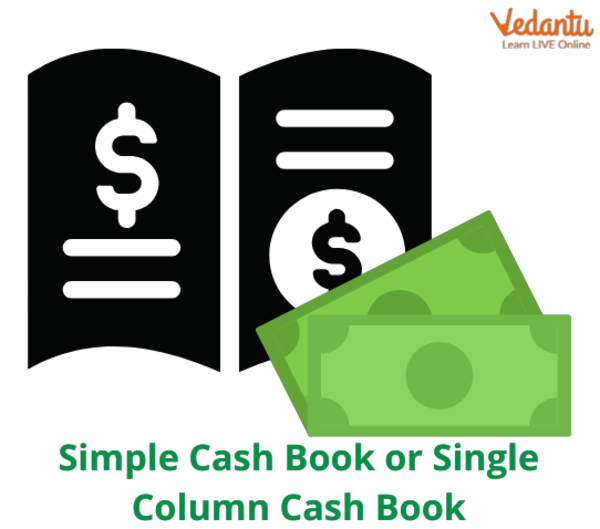




What is the Single-Column Cash Book?
Cash transactions are recorded in just one column of the cash book. It's essentially the same thing as a checking account. Every credit and debit side of the cash book format just contains a single amount line. Cash inflows are recorded in the debit column, while outflows are accounted for in the credit column. The single-column cash book is designed to make it simple for businesses to keep track of their cash flows over a certain period. Moreover, a cash book means you figure out how much money you have left over after the fiscal year.

Single-Column Cash Book
A cash book with just one column represents nothing more than an account for cash. Because you can't "pay with what you don't have," a cash book cannot display a credit status. That's why it's never normal for a cash account to be positive.
Cash Book Format in Detail
The cash book will show the owner the actual state of the company's cash flow. The debit entries are on the left side of a 'T' shaped currency book, while the credits are on the right.
The cash inflows are represented by the "debit" column and the "cash outflows" column. Every cash inflow is recorded on the cash book's receipt side, and every cash outflow is documented on the cash book's payment side.
The balance is calculated by subtracting the amount received from the amount paid out after the day or period. This figure represents a company's available cash on hand. The cash book is a record of all monetary transactions.
The following cash book example elaborates on each section of the one-column cash account; here is the single-column cash book format:
Date: - It keeps track of the day, month, and year a deal was made (receipts and payments). It is unnecessary to provide the month and year for every transaction if they all occurred within the same calendar and month.
Explanation: - If money is collected, the account's identity goes on the debit column. So if money is given, the account's name goes on the credit column. Cash holdings for a specific time are recorded first, then transactions for that period are reported.
Defining Cash Book

What does Cash Book records?
To keep track of all of your financial dealings, big and small, cash or check, you should keep a cash book. It is possible to keep track of financial transactions in a cash book, which serves as a diary and a ledger.
Cash transactions, including purchases, payments, and credit sales, are recorded in a cash book. The payment date, client name (if applicable), and account that will be debited (minus amount) or credited (plus amount) will all be shown (minus amount). The remaining balance is recorded as "cash" in the accounting ledger when the day is through.
The cash book records all transactions involving cash. Cash in the bank, in the till, sales tax, etc. Income is kept in the simple cash book in both a notebook and a ledger. Cash outflows and inflows are recorded, making it a "double-entry" bookkeeping record. In accounting, debits signify value increases or account for assets, whereas credits signify losses in value or records for liabilities.
Things to Know for Posting Cash Book Entries

Posting entries in a Cash Account
A cash book is not the same as one cash account. Cash operations are maintained in a cash book, a specialised ledger, rather than a cash account that is part of the general ledger.
When it comes to keeping track of money, a cash account is set up, resembling a ledger, while a cash book combines the functions of the two.
Every cash book transaction is recorded regularly to the applicable general ledger and subsidiary ledger accounts. What follows is a description of how to make a posting:
Cash book b/d and c/d (i.e. daily beginning and ending balances) are not reported.
A cash book's debit (or receipt) side transactions or entries are transferred to the ledger's credit (payment) side columns.
The debit sides of the corresponding ledger accounts are updated with the cash book's credit ground (or payout side) entries.
The posting source section of the single-column cash book contains the reference list of the ledger for which the transactions have been transferred. It's simple to look up a particular ledger account and see the updated balance.
DR CR
Advantages of Manual Cash Book Format
There are two cash columns in the manual cash book format style. The debits will be shown in one column and the credits in another. Each entry's first line specifies the date, applicable client names, and the account that will be debited or credited. At the bottom of each section is the final tally.
Keeping a cash book account format may benefit you in the listed ways:
To begin, most exchanges in almost all commercial enterprises are monetary. It would take an inordinate amount of time and effort to credit and debit the cash balance for every activity when a cash book was not kept, and money transfers were not noted in the journal.
As cash is readily taken by dishonest personnel, it is essential that the cash track is updated and adequately controlled by a responsible person. This leads to the second benefit. For this reason, keeping an accurate and organised cash book detailing all monetary exchanges is crucial.
Conclusion
All cash transactions for a given day at a business are recorded in a special ledger called the cash book, which is distinct from the cash account towards which entries are made within the journal. The cash account's balancing entries need not be sent to the general ledger. After making changes, the general ledger is updated.
In a nutshell, a cash book facilitates efficient cash management by allowing management to keep track of cash plus bank accounts and make choices based on this information.
FAQs on Single-Column Cash Book: Everything You Need to Know
1. What is a Single-Column Cash Book and what is its primary purpose in accounting?
A Single-Column Cash Book, also known as a simple cash book, is a primary book of entry that exclusively records all cash receipts and cash payments of a business. Its primary purpose is to provide a simple and chronological record of cash flow. Since it combines the functions of both a journal and a ledger for cash transactions, it eliminates the need to create a separate Cash Account in the general ledger, simplifying the bookkeeping process for small businesses.
2. What is the standard format of a Single-Column Cash Book as per the CBSE Class 11 syllabus?
The Single-Column Cash Book follows a 'T-shape' format with two distinct sides. The left side is the Debit (Dr.) side for recording all cash receipts, and the right side is the Credit (Cr.) side for recording all cash payments. Each side contains the following columns:
Date: The date of the transaction.
Particulars: The name of the account affected by the cash transaction.
V.N. (Voucher Number): The serial number of the supporting document (e.g., receipt, invoice).
L.F. (Ledger Folio): The page number of the ledger where the corresponding account is posted.
Amount (₹): The monetary value of the transaction.
3. What are the fundamental rules for making entries in a Single-Column Cash Book?
The preparation of a Single-Column Cash Book is based on the rule for Real Accounts: 'Debit what comes in, and Credit what goes out'. Therefore, the two fundamental rules are:
All cash receipts (cash coming into the business) are recorded on the Debit (Dr.) side.
All cash payments (cash going out of the business) are recorded on the Credit (Cr.) side.
It is crucial to remember that only cash transactions are recorded; credit transactions are omitted entirely.
4. How do you prepare and balance a Single-Column Cash Book at the end of a period?
To prepare and balance a Single-Column Cash Book, you should follow these steps:
Begin with the opening cash balance, recorded on the debit side as 'To Balance b/d'.
Record all subsequent cash receipts chronologically on the debit side.
Record all cash payments chronologically on the credit side.
At the end of the period, total the amount columns on both the debit and credit sides.
Calculate the closing balance by finding the difference between the total receipts (debit side) and total payments (credit side).
Enter this closing balance on the credit side as 'By Balance c/d' (carried down) to make the totals of both sides equal. This closing balance becomes the opening balance for the next period.
5. How does a Single-Column Cash Book differ from a standard Cash Account in the ledger?
While both track cash, a Single-Column Cash Book and a Cash Account have key differences. A Cash Book is a subsidiary book (a book of original entry), meaning transactions are recorded here first. It also serves as a principal book because it replaces the need for a separate Cash Account in the ledger. In contrast, a Cash Account is purely a ledger account (a principal book) and transactions are posted to it from the Journal. Essentially, the Cash Book performs a dual role that a simple Cash Account does not.
6. Why are credit transactions, such as goods bought on credit, completely ignored in a Single-Column Cash Book?
A Single-Column Cash Book is designed to track the actual movement of cash. Credit transactions are ignored because they do not involve an immediate inflow or outflow of physical cash. For example, when goods are purchased on credit, the business's cash balance does not change at that moment. Such transactions are recorded in other subsidiary books, like the Purchases Book or Sales Book. The cash book will only reflect the transaction when the cash is actually paid or received later.
7. In which business scenarios is a Single-Column Cash Book most suitable, and what are its main limitations?
A Single-Column Cash Book is most suitable for small businesses, sole proprietorships, and organisations that primarily deal in cash and have very few or no bank transactions. Its main limitation is its simplicity. It becomes insufficient for businesses that:
Frequently use banking services (deposits, withdrawals, cheques).
Regularly handle trade discounts and cash discounts.
For such businesses, a Double-Column or Triple-Column Cash Book is necessary to track bank and discount transactions alongside cash.
8. What is the significance of the 'L.F.' column in the cash book format?
'L.F.' stands for Ledger Folio. Its purpose is to serve as a cross-reference. When a transaction from the cash book is posted to the corresponding account in the general ledger (e.g., Salary Account, Sales Account), the page number of that ledger account is written in the L.F. column. This practice, known as posting, ensures that every entry is properly linked and makes auditing or tracing transactions much easier.
9. Can a Single-Column Cash Book ever show a credit balance? Why or why not?
No, a Single-Column Cash Book can theoretically never show a credit balance. A credit balance would imply that cash payments (credit side) are greater than cash receipts (debit side), which means the business has spent more physical cash than it possessed. This is physically impossible. The cash balance can be zero, but it cannot be negative. Therefore, the debit side total will always be greater than or equal to the credit side total before balancing.
10. How does the concept of a 'contra entry' relate to a Single-Column Cash Book?
The concept of a contra entry does not apply to a Single-Column Cash Book. A contra entry is a transaction that affects both cash and bank accounts, such as depositing cash into the bank or withdrawing cash from the bank for office use. Since a Single-Column Cash Book only has a column for cash transactions and not for bank transactions, it cannot accommodate entries that involve both. Contra entries are a specific feature of Double-Column and Triple-Column Cash Books.























